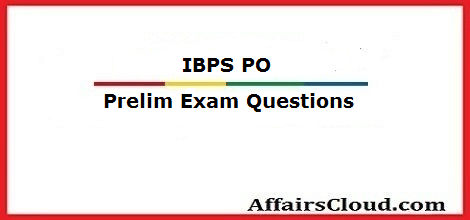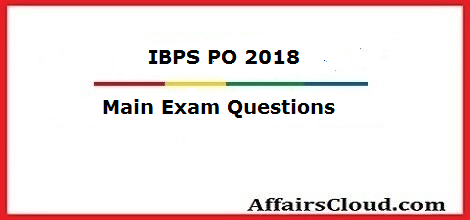IBPS PO Prelim Questions Asked in Exam 13 October 2018. This article covers the Questions asked in IBPS IBPS PO Prelim 2018
Help:- Share your Exam Questions in Comments Sections
Note:- Keep your Eye on this page, We ll update more Questions
IBPS PO 2018 Prelim – 13 October

Wrong Number series:
2, 3, 8, 31, 154, 924, 6460
4, 5.1, 7.3, 10.6, 15, 20, 27.1
141, 156, 147, 162, 153, 165, 159
252, 252, 254, 227, 243, 118, 154
0.5, 2, 1, 4, 32, 512, 16384
Missing Number series:
3,2,19,39,?,103
14,28,84,336,?,10080
11,15,31,67,131,?
10,40,60,72,78,?
18,20,16,24,?,40
Quadratic Equation:
2x² + 9x + 9 = 0, 15y²+ 16y + 4= 0
6x² – 11x +4 = 0, 3y² – 5y + 2 =0
2x³ = √256, 2y² – 9y + 10 = 0
3x² + 11x +10 = 0, 2y² + 11y + 14 = 0
21x²+ 10x + 1 = 0, 24y² + 26y + 5 = 0
Caselet:
Total 450 vouchers were distributed by a salon for complimentary hair cut and pedicure. Number of Vouchers redeemed by male were 34 more than that of females. The ratio of vouchers redeemed by males to female is 13:7. Number of vouchers redeemed by male for hair cut were 15 more than that of vouchers redeemed by males for pedicure.
(Not necessary that all vouchers were redeemed)
Miscellaneous:
A can do a work in 20 days. B is 25% more efficient than A. A works for 6 days before leaving, the. C completes remaining work in 21 days. In how much time C alone can do the work?
English:
Reading Comprehension:
People have long circulated news via word-of-mouth, and as language evolved into writing and literacy – and governments played larger roles in people’s lives – sharing information became a necessity. However, disseminating news and information on paper presented significant challenges. When each copy had to be handwritten, mass distribution was impossible. The invention of the printing press paved the way for “true” newspapers The first true newspapers arrived after Johannes Gutenberg introduced his movable type printing press to the European world around 1440. Though printing presses with movable type had existed in eastern Asia for around two centuries, they never made it to Europe; furthermore, Gutenberg’s version made it significantly faster to mass produce documents.
By 1500, the printing press had made its way throughout Europe, and news sheets (or news books) were mass-distributed. The first weekly newspaper was published in Germany by Johann Carolus in 1604. Called Relation aller Fürnemmen und gedenckwürdigen Historien, the publication satisfied the four tenets of a “true” newspaper: • Accessibility by the public • Published at a regular interval (daily, weekly, monthly, etc.) • Information is current • Covers a variety of topics (politics, events, entertainment, sports, etc.) Despite meeting the requirements for a newspaper, there is some debate as to whether The Relation qualifies as the world’s first newspaper since it was printed in quarto, not folio, size. It’s worth noting the World Association of Newspapers considers The Relation the first true newspaper.
Other German newspapers followed, and in 1618 the world’s first broadsheet newspaper printed in folio size was published in Amsterdam, called Courante uyt Italien, Duytslandt, &c. The newspaper format soon spread throughout Europe, with newspapers published in Spain, France, and Sweden. The first English newspaper was published in 1665 in Oxford, England. Known as the Oxford Gazette, the newspaper moved to London in 1666 and was renamed the London Gazette. It’s still being published today.
These mismatched graduates face poorer prospects and lower earnings than their peers who embark on careers that are a better fit for the knowledge and skills they have acquired through three or four years of study. It suggests that traditional careers advice isn’t working. The problem isn’t necessarily that too many students are taking the wrong course. There is little evidence that graduates are studying the “wrong” subjects, according to the UUK research, since most are on courses that offer subject knowledge and employability skills that are very much in demand.
Politicians complain of a, but graduates face an “experience gap” – with many employers preferring to recruit young people who have spent a couple of years in the workplace rather than raw recruitments from the university.
To help graduates find the right jobs for them, lots of universities are experimenting with new ways to make their careers advice more accessible and meaningful. At the University of Kent, students can use an online Careers Explorer service to match their skills to career options, and a work-study scheme that provides bursaries for work experience. Students at the University of Dundee can take employability modules in parallel with their academic work, including online and personal career planning sessions.




